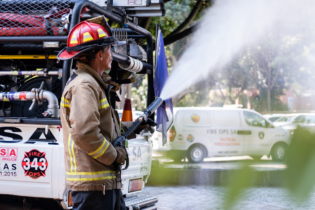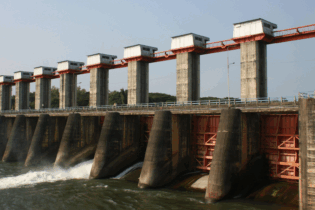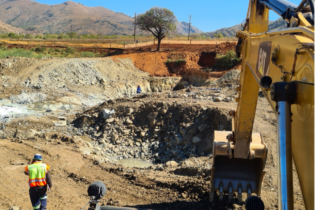Over the past three years, Talbot have sponsored well over 1000 E. Coli tests, of which 46% have been non-compliant. Some of the results have shown astronomically high E. Coli levels, that is caused by raw sewage being pumped into the river system.
Paddling used to be a favourite sport for Talbot CEO, Carl Haycock. But after experiencing raw sewage in the Umgeni River first hand, he put away his paddles and launched Talbot into action.
Talbot initially sponsored E. coli testing for the Umgeni River, Umdloti River and Msunduzi River, helping canoeists to make informed decisions on whether it’s safe to use these rivers recreationally. A few years later, the company joined forces with Adopt a River to expand its water quality testing efforts, which now include testing Durban’s Golden Mile and the Umhlanga beaches. In Gauteng, Talbot have also been sponsoring regular water quality testing for the Hennops River Revival in Tshwane. These results, released weekly on Talbot’s website and social media channels, are followed closely by community members and local businesses. Academics are also using the data for their research. “There was increased interest in our water quality monitoring tests after the 2022 Durban floods damaged the city’s wastewater treatment and sanitation infrastructure, resulting in high levels of E. coli in rivers and beaches. There is a strong correlation between extreme rainfall events and pollution in our rivers and seas,” says Micole Martens, director, Talbot.“We test for E. coli because it serves as a reliable indicator of faecal contamination in freshwater and marine environments. While Enterococci would provide a more accurate measure, it is a significantly more expensive test, making it an unsustainable option given that these tests are sponsored,” she adds.The samples are taken at predetermined sections of the rivers and beaches, that are recreational hotspots and are known problem areas of E. coli discharge. Samples are also taken at river mouths before they flow into the ocean.
Deteriorating water quality
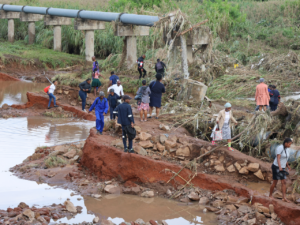 Interestingly, Talbot’s water quality test results have garnered attention from professionals and companies around the world. Haycock notes that this is because deteriorating water quality in river systems is not exclusively a South African problem. “At the Paris Olympics, the first swimming event in the Seine River was postponed due to ongoing concerns about water pollution. In 2022, a House of Commons Committee report concluded that no river in England was free from chemical contamination.”
Freshwater systems are one of the most threatened ecosystems on the planet. In almost every populated catchment, humans have to a greater or lesser degree increased the discharge of pollution. Wastewater quality affects the system directly, in the same way that pollution from mining, agriculture and other industries have a negative impact on the resource.
Haycock emphasises that water quality monitoring is more widespread than the public generally perceives, extending well beyond Talbot’s highly publicised tests. “The government does a lot of water quality monitoring of their own. The Department of Water and Sanitation has national monitoring programmes that mostly monitor raw surface water quality in rivers and dams and produce long-term trend reports and visualisations. The eThekwini Municipality’s Water and Sanitation Scientific Services take numerous samples from the rivers and beaches at different points monthly and test for a variety of parameters. The city has previously partnered with us to conduct joint readings that allow for a credible comparison of test results in the interests of transparency and public safety. During this exercise, the results produced were similar.”
Talbot focuses on making their water quality tests accessible and understandable to the public. “It is important to educate the public on the water quality of rivers and beaches, but to also prompt more action in looking after and valuing our water resources and create general awareness around the sustainable use of water. These water quality results are a tool that can be used by the public to put pressure on whoever is causing a pollution event. The river and marine environment are being used as a dumping ground for sewage and chemicals,” explains Haycock.
Interestingly, Talbot’s water quality test results have garnered attention from professionals and companies around the world. Haycock notes that this is because deteriorating water quality in river systems is not exclusively a South African problem. “At the Paris Olympics, the first swimming event in the Seine River was postponed due to ongoing concerns about water pollution. In 2022, a House of Commons Committee report concluded that no river in England was free from chemical contamination.”
Freshwater systems are one of the most threatened ecosystems on the planet. In almost every populated catchment, humans have to a greater or lesser degree increased the discharge of pollution. Wastewater quality affects the system directly, in the same way that pollution from mining, agriculture and other industries have a negative impact on the resource.
Haycock emphasises that water quality monitoring is more widespread than the public generally perceives, extending well beyond Talbot’s highly publicised tests. “The government does a lot of water quality monitoring of their own. The Department of Water and Sanitation has national monitoring programmes that mostly monitor raw surface water quality in rivers and dams and produce long-term trend reports and visualisations. The eThekwini Municipality’s Water and Sanitation Scientific Services take numerous samples from the rivers and beaches at different points monthly and test for a variety of parameters. The city has previously partnered with us to conduct joint readings that allow for a credible comparison of test results in the interests of transparency and public safety. During this exercise, the results produced were similar.”
Talbot focuses on making their water quality tests accessible and understandable to the public. “It is important to educate the public on the water quality of rivers and beaches, but to also prompt more action in looking after and valuing our water resources and create general awareness around the sustainable use of water. These water quality results are a tool that can be used by the public to put pressure on whoever is causing a pollution event. The river and marine environment are being used as a dumping ground for sewage and chemicals,” explains Haycock.
Talbot Analytics
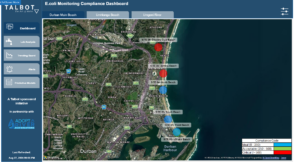
Talbot Analytics Dashboard
Talbot then collects these samples at a central location and tests them at their SANAS-accredited laboratory.
Data collection and capturing require human intervention and this can lead to inaccuracies. But as Tabot’s laboratory is SANAS accredited, they follow numerous quality tests. Once approved, the data is entered into a laboratory information system and is then pulled through to TalbotAnalytics. A digital tool, TalbotAnalytics empowers users to visualise and interpret their data as well as predict future trends. According to Boitumelo Matshediso, the business unit manager of TalbotAnalytics, water quality data can be complex to interpret. “When entering the E. Coli test results into the software, we can display the findings in a simple format. You do not have to be a water scientist to be able to understand the outcomes of these test results.” Matshediso has used TalbotAnalytics and predictive modelling to provide the community with festive season estimates of E. Coli levels at recreational hotspots. “It is important to understand that both marine and freshwater systems are transient. Any sample that we take is representative of the concentration of the contaminant at that point in time at that location. If a sample is taken ten minutes later, results may differ. This is why it is incredibly important to analyse trends over a period. Are the tests at that location relatively consistent?” explains Haycock. Over the past three years, Talbot have sponsored well over 1000 E. Coli tests, of which 46% have been non-compliant. Some of the results have shown astronomically high E. Coli levels, that is caused by raw sewage being pumped into the river system.Private sector
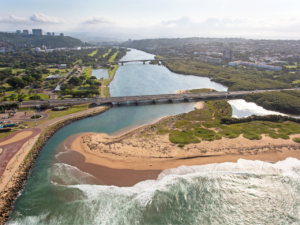
Umgeni River Mouth






